Related Research Articles

Spiral galaxies form a class of galaxy originally described by Edwin Hubble in his 1936 work The Realm of the Nebulae and, as such, form part of the Hubble sequence. Most spiral galaxies consist of a flat, rotating disk containing stars, gas and dust, and a central concentration of stars known as the bulge. These are often surrounded by a much fainter halo of stars, many of which reside in globular clusters.

A ring galaxy is a galaxy with a circle-like appearance. Hoag's Object, discovered by Art Hoag in 1950, is an example of a ring galaxy. The ring contains many massive, relatively young blue stars, which are extremely bright. The central region contains relatively little luminous matter. Some astronomers believe that ring galaxies are formed when a smaller galaxy passes through the center of a larger galaxy. Because most of a galaxy consists of empty space, this "collision" rarely results in any actual collisions between stars. However, the gravitational disruptions caused by such an event could cause a wave of star formation to move through the larger galaxy. Other astronomers think that rings are formed around some galaxies when external accretion takes place. Star formation would then take place in the accreted material because of the shocks and compressions of the accreted material.
A galactic halo is an extended, roughly spherical component of a galaxy which extends beyond the main, visible component. Several distinct components of galaxies comprise the halo:

A barred spiral galaxy is a spiral galaxy with a central bar-shaped structure composed of stars. Bars are found in about two thirds of all spiral galaxies. Bars generally affect both the motions of stars and interstellar gas within spiral galaxies and can affect spiral arms as well. The Milky Way Galaxy, where the Solar System is located, is classified as a barred spiral galaxy.

Messier 94 is a spiral galaxy in the mid-northern constellation Canes Venatici. It was discovered by Pierre Méchain in 1781, and catalogued by Charles Messier two days later. Although some references describe M94 as a barred spiral galaxy, the "bar" structure appears to be more oval-shaped. The galaxy has two ring structures.

The Milky Way is the galaxy that includes our Solar System, with the name describing the galaxy's appearance from Earth: a hazy band of light seen in the night sky formed from stars that cannot be individually distinguished by the naked eye. The term Milky Way is a translation of the Latin via lactea, from the Greek γαλακτικός κύκλος, meaning "milky circle." From Earth, the Milky Way appears as a band because its disk-shaped structure is viewed from within. Galileo Galilei first resolved the band of light into individual stars with his telescope in 1610. Until the early 1920s, most astronomers thought that the Milky Way contained all the stars in the Universe. Following the 1920 Great Debate between the astronomers Harlow Shapley and Heber Curtis, observations by Edwin Hubble showed that the Milky Way is just one of many galaxies.
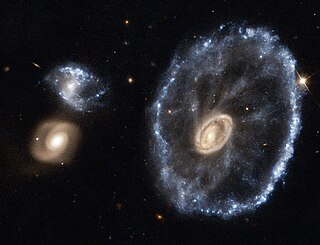
The Cartwheel Galaxy (also known as ESO 350-40 or PGC 2248) is a lenticular galaxy and ring galaxy about 500 million light-years away in the constellation Sculptor. It is an estimated 150,000 light-years diameter, and has a mass of about 2.9–4.8 × 109 solar masses; its outer ring has a circular velocity of 217 km/s.
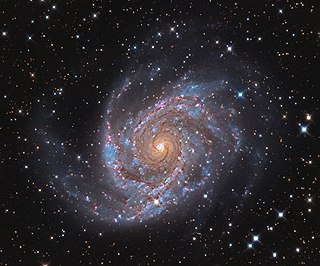
NGC 2997 is a face-on unbarred spiral galaxy about 40 million light-years away in the faint southern constellation of Antlia. It was discovered March 4, 1793 by German-born astronomer William Herschel. J. L. E. Dreyer described it as, "a remarkable object, very faint, very large, very gradually then very suddenly bright middle and 4 arcsec nucleus. This is the brightest galaxy of the NGC 2997 group of galaxies, and was featured on the cover of the first edition of Galactic Dynamics by James Binney and Scott Tremaine.
A secular resonance is a type of orbital resonance between two bodies with synchronized precessional frequencies. In celestial mechanics, secular refers to the long-term motion of a system and resonance is when two periods or frequencies are a simple numerical ratio of small integers. Typically, the synchronized precessions in secular resonances are between the rates of change of the argument of the periapses or the rates of change of the longitude of the ascending nodes of two system bodies. Secular resonances can be used to study the long-term orbital evolution of asteroids and their families within the asteroid belt (see the uci780 resonance below).
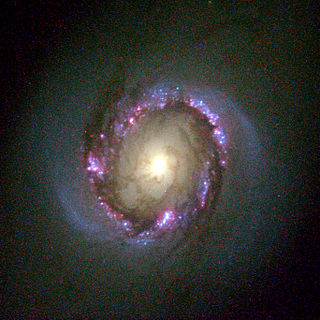
NGC 4314 is a barred spiral galaxy approximately 53 million light-years away in the northern constellation of Coma Berenices. It is positioned around 3° to the north and slightly west of the star Gamma Comae Berenices and is visible in a small telescope. The galaxy was discovered by German-born astronomer William Herschel on March 13, 1785. It was labelled as peculiar by Allan Sandage in 1961 because of the unusual structure in the center of the bar. NGC 4314 is a member of the Coma I group of galaxies.
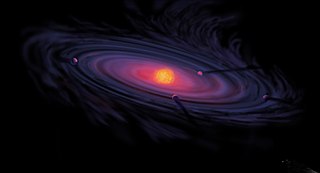
The formation of the Solar System began about 4.6 billion years ago with the gravitational collapse of a small part of a giant molecular cloud. Most of the collapsing mass collected in the center, forming the Sun, while the rest flattened into a protoplanetary disk out of which the planets, moons, asteroids, and other small Solar System bodies formed.

Density wave theory or the Lin–Shu density wave theory is a theory proposed by C.C. Lin and Frank Shu in the mid-1960s to explain the spiral arm structure of spiral galaxies. The Lin–Shu theory introduces the idea of long-lived quasistatic spiral structure. In this hypothesis, the spiral pattern rotates in a particular angular frequency, whereas the stars in the galactic disk are orbiting at a different speed depending on their distance to the galaxy center. The presence of spiral density waves in galaxies has implications on the star formation, since the gas orbiting around the galaxy may be compressed and form shock periodically. Theoretically, the formation of global spiral pattern is treated as an instability of the stellar disk caused by the self-gravity, as opposed to tidal interactions. The mathematical formulation of the theory has also been extended to other astrophysical disk systems, such as Saturn's rings.
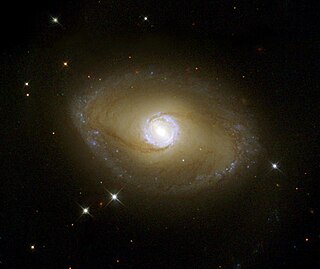
NGC 6782 is a barred spiral galaxy located in the southern constellation of Pavo, at a distance of approximately 173 megalight-years from the Milky Way. It was discovered on July 12, 1834 by English astronomer John Herschel. John L. E. Dreyer described it as, "considerably faint, considerably small, round, a little brighter middle, 9th magnitude star to south". The morphological classification of NGC 6782 is (R1R′2)SB(r)a, indicating a barred spiral galaxy with a multiple ring system and tightly-wound spiral arms. It is seen nearly face-on, being inclined by an angle of 27.2°±0.2° to the line of sight from the Earth.

NGC 5962 is a spiral galaxy in the equatorial constellation of Serpens Caput. It was discovered by the Anglo-German astronomer William Herschel on March 21, 1784. The NGC 5962 galaxy is located at a distance of 120 million light years and is receding with a heliocentric radial velocity of 1,957 km/s. It is the brightest member of the eponymously-named NGC 5962 group, which overlaps with the nearby NGC 5970 group; the two groups may be gravitationally bound.
This glossary of astronomy is a list of definitions of terms and concepts relevant to astronomy and cosmology, their sub-disciplines, and related fields. Astronomy is concerned with the study of celestial objects and phenomena that originate outside the atmosphere of Earth. The field of astronomy features an extensive vocabulary and a significant amount of jargon.
In astrobiology and planetary astrophysics, the galactic habitable zone is the region of a galaxy in which life might most likely develop. The concept of a galactic habitable zone analyzes various factors, such as metallicity and the rate and density of major catastrophes such as supernovae, and uses these to calculate which regions of a galaxy are more likely to form terrestrial planets, initially develop simple life, and provide a suitable environment for this life to evolve and advance. According to research published in August 2015, very large galaxies may favor the birth and development of habitable planets more than smaller galaxies such as the Milky Way. In the case of the Milky Way, its galactic habitable zone is commonly believed to be an annulus with an outer radius of about 10 kiloparsecs (33,000 ly) and an inner radius close to the Galactic Center.
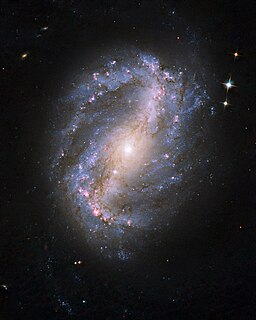
NGC 6217 is a barred spiral galaxy located some 67 million light years away, in the constellation Ursa Minor. It can be located with a 10 cm (4 in) or larger telescope as an 11th magnitude object about 2.5° east-northeast of the star Zeta Ursae Minoris. The galaxy is inclined by an angle of 33° to the line of sight along a position angle of 162°.
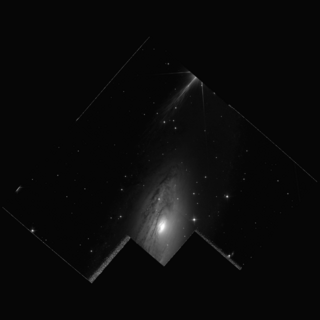
NGC 7013 is a relatively nearby spiral or lenticular galaxy estimated to be around 37 to 41.4 million light-years away from Earth in the constellation of Cygnus. NGC 7013 was discovered by English astronomer William Herschel on July 17, 1784 and was also observed by his son, astronomer John Herschel on September 15, 1828.
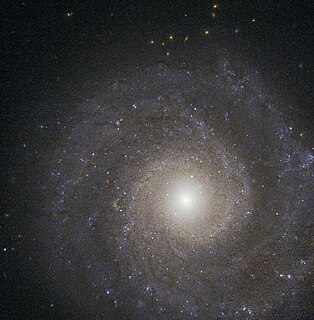
IC 1993 is an intermediate spiral galaxy in the constellation Fornax. It was discovered by Lewis Swift on November 19, 1897. At a distance of about 50 million light-years, and redshift of 1057 km/s, it is one of the closest to us of the 200 galaxies in the Fornax Cluster.
References
- ↑ Binney, James; Tremaine, Scott (1988). Galactic dynamics (Princeton series in astrophysics). Princeton University Press. p. 149. ISBN 978-0-691-08445-9.
- ↑ Miyama, Shoken M.; Tomisaka, Kohji; Hanawa, Tomoyuki (1999). Numerical astrophysics: proceedings of the International Conference on Numerical Astrophysics 1998 (NAP98). Springer. p. 162. ISBN 978-0-7923-5566-3.
- ↑ Johnstone, D. (2004). Star formation in the interstellar medium: in honor of David Hollenbach, Chris McKee, and Frank Shu. Astronomical Society of the Pa. p. 73. ISBN 978-1-58381-185-6.
- ↑ Shu, Frank H. (1992). The Physics of Astrophysics: Gas dynamics. University Science Books. p. 147. ISBN 978-0-935702-65-1.